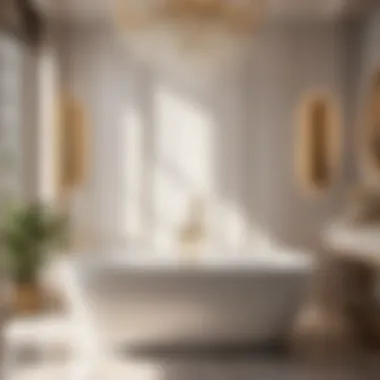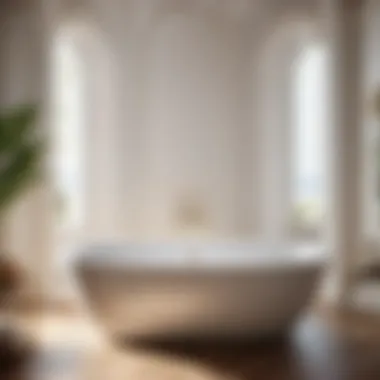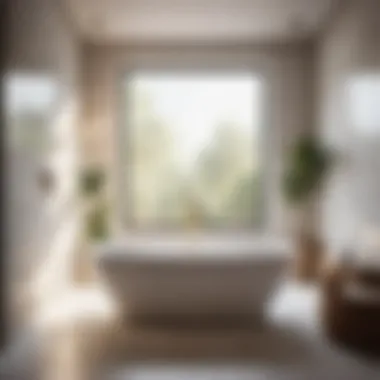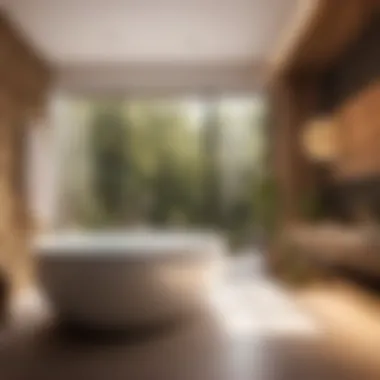Elevate Your Bathing Experience: The Definitive Guide to Bathtub Comfort


Materials:
- Acrylic bathtub: 60 inches long, 30 inches wide, 20 inches deep
- Bathtub faucet set: with hot and cold water handles
- Waterproof silicone sealant
- Level
- Screwdriver
- Pipe wrench
DIY Steps:
- Prepare the Area: Clear the space where the bathtub will be installed. Ensure the floor is level to prevent future issues.
- Place the Bathtub: Carefully position the acrylic bathtub in the designated area, ensuring it fits perfectly without any gaps.
- Install the Faucet Set: Connect the hot and cold water handles to the plumbing system, using a pipe wrench to secure them in place.
- Seal Around the Edges: Apply waterproof silicone sealant along the edges of the bathtub to prevent leaks and ensure a tight seal.
- Check for Level: Use a level to confirm that the bathtub is perfectly level in all directions.
Technical Aspects:
- Timing: Allocate a day for this project to ensure ample time for precision and detail.
- Tools: Screwdriver and pipe wrench are essential for this installation.
- Critical Techniques: Ensuring a level surface is crucial for the proper functioning of the bathtub.
DIY Project Process:
- Step 1 - Preparation: Clear the area, check for level
- Step 2 - Installation: Place the bathtub, install the faucet set
- Step 3 - Finishing: Seal the edges, check for level
- Troubleshooting Tips: If leaks occur, check the silicone sealant application and reapply as needed.
Choosing the Right Bathtub
When it comes to creating the ultimate bathing experience, selecting the right bathtub is a crucial decision that can significantly impact your daily relaxation ritual. The choice between a freestanding and built-in bathtub sets the tone for the overall aesthetic and comfort of your bathing space. Understanding the specific elements, benefits, and considerations of each option is essential to curating a luxurious and tranquil bath retreat in your home.
Freestanding vs. Built-in Bathtubs
Freestanding bathtubs exude a sense of luxury and sophistication, making them a favored choice for those seeking a statement piece in their bathroom. The pros of freestanding tubs include their versatility in placement, allowing for a more customized layout and design aesthetic. They often come in a variety of styles and materials, enhancing the overall ambiance of the bathroom.
On the other hand, built-in bathtubs are known for their seamless integration into the overall bathroom design. Their streamlined look and space-saving qualities make them a practical choice for smaller bathrooms or those aiming for a more cohesive design. While built-in tubs may lack the visual impact of freestanding counterparts, they make up for it in functionality and ease of maintenance.
Pros and Cons of Freestanding Bathtubs
When it comes to freestanding bathtubs, their standout feature lies in their ability to become the focal point of the bathroom, adding a touch of elegance and luxury. The freedom to place them anywhere in the room allows for a more creative and personalized layout. However, potential drawbacks include a higher price point and the need for extra space around the tub for cleaning purposes.
Pros and Cons of Built-in Bathtubs
Built-in bathtubs offer a seamless and integrated look that blends harmoniously with the rest of the bathroom decor. Their space-saving design makes them ideal for smaller bathrooms or those aiming for a more uniform aesthetic. Yet, the limitations in placement and design options may restrict creativity in configuring the bathroom space.
Material Matters
The choice of material for your bathtub plays a significant role in both its durability and aesthetic appeal. Understanding the characteristics and pros and cons of materials such as acrylic, cast iron, fiberglass, and stone resin can guide you in selecting the most suitable option for your bathing sanctuary.
Acrylic


Acrylic bathtubs are lightweight and easy to install, making them a popular choice for homeowners looking for a cost-effective and versatile option. Their smooth surface is easy to clean and resists staining, while their insulating properties help keep the water warm for more extended periods. However, acrylic tubs are prone to scratching and may not have the same longevity as other materials.
Cast Iron
Renowned for their durability and heat retention qualities, cast iron bathtubs are a timeless choice that can last for generations with proper care. The weight of cast iron provides a sense of stability and substance, while their enamel finish adds a classic touch to any bathroom. However, the hefty weight of cast iron bathtubs can make installation more challenging and costly.
Fiberglass
Fiberglass bathtubs offer a lightweight and affordable option that is easy to maintain and install. Their customizable shapes and sizes make them a versatile choice for varying bathroom layouts. However, fiberglass tubs may lack the same heat retention as other materials and are more prone to cracking or fading over time.
Stone Resin
Combining the durability of natural stone with the versatility of resin, stone resin bathtubs offer a luxurious and sophisticated option for discerning homeowners. Their non-porous surface resists mold and mildew growth, while their solid construction provides excellent heat retention for a more relaxing bathing experience. Nevertheless, the premium cost of stone resin tubs may be a deterrent for budget-conscious individuals.
Size and Dimensions
Ensuring that the bathtub's size and dimensions align with your needs and space constraints is vital for creating a comfortable and functional bathing environment. Understanding the standard sizes available on the market and the customization options offered can guide you in selecting a bathtub that fits seamlessly into your bathroom layout.
Standard Sizes
Standard bathtub sizes range from the compact yet deep to the spacious and indulgent, allowing homeowners to choose a size that suits their bathing preferences. Factors such as the available space in the bathroom and the desired level of comfort will influence the ideal bathtub dimensions for your home. It is essential to consider accessibility and ease of use when selecting a standard size bathtub.
Customization Options
For those looking to elevate their bathing experience to a personalized level, customization options for bathtubs offer a myriad of possibilities. From selecting the material and shape to adding features such as built-in jets or lighting, customized bathtubs allow you to tailor every aspect to your preferences. While customization offers unparalleled creativity and comfort, it often comes with a higher price tag and longer lead times for production.
Enhancing Comfort Features
When it comes to creating the ultimate bath experience, enhancing comfort features play a pivotal role in elevating relaxation to new heights. These elements focus on optimizing comfort and functionality, ensuring a soothing and rejuvenating bathing session. By integrating thoughtful design and innovative technologies, enhancing comfort features contribute significantly to the overall ambiance of your bath retreat.
Ergonomic Design
Embracing ergonomic design in your bathtub selection is essential for promoting comfort and reducing stress on the body. Sloped backrests are a key component of ergonomic design, providing support to the spine and allowing for a more comfortable bathing position. The gentle incline of sloped backrests helps reduce muscle tension and promotes relaxation, making it a popular choice for those seeking a therapeutic bathing experience.
Armrests are another crucial aspect of ergonomic design, offering additional support and stability while bathing. They assist in maintaining proper posture and reducing fatigue during extended soaking periods. The presence of armrests enhances comfort by allowing users to rest their arms and relax fully without straining their muscles.
Non-slip surfaces are imperative for ensuring safety and comfort in the bathtub. These surfaces provide traction and prevent slipping or accidents while moving in and out of the tub. Incorporating non-slip materials into your bathtub design offers peace of mind and a secure bathing environment, enhancing the overall comfort and usability of your bathing space.
Hydrotherapy Options


Exploring hydrotherapy options opens up a realm of therapeutic benefits for your bathing experience. Air jets create a gentle, bubbling massage effect that promotes circulation and relieves muscle tension. The soothing sensation of air jets enhances relaxation and helps create a spa-like ambiance in your own home.
Water jets deliver targeted streams of water to specific areas of the body, offering a customizable massage experience. The pulsating action of water jets can alleviate aches and pains, making them ideal for individuals seeking localized therapeutic benefits during their bath time.
Combo systems combine the benefits of air and water jets, providing a comprehensive hydrotherapy experience. The synergy between air and water jets offers a versatile approach to relaxation, allowing users to customize their bathing experience according to their preferences. With a range of intensities and massage patterns, combo systems cater to varying relaxation needs, ensuring a personalized and indulgent bath session.
Heating Technology
Integrating advanced heating technology into your bathtub enhances comfort and prolongs relaxation. Built-in heaters maintain the water temperature at your desired level, ensuring a consistent and cozy bathing experience throughout your soak. This technology prevents the water from cooling too quickly, allowing you to unwind unhurriedly and enjoy extended bath sessions.
Thermal insulation plays a crucial role in retaining heat within the bathtub, enhancing energy efficiency and comfort. Insulated bathtubs conserve warmth, reducing energy consumption and optimizing the longevity of your bath water's temperature. By minimizing heat loss, thermal insulation preserves the soothing warmth of your bath, creating a spa-like environment in your bathroom.
Ambiance and Relaxation
In the realm of creating the ultimate bathtub comfort, ambiance and relaxation play a crucial role in elevating the bathing experience to a luxurious level. The ambience of a bathroom can significantly impact one's state of mind, offering a retreat from the stresses of daily life. When it comes to relaxation, setting the mood through various elements can turn a regular bath into a soothing sanctuary.
Lighting Solutions
LED Mood Lighting
LED mood lighting is a specific aspect that transforms the ambiance of a bathroom. The key characteristic of LED mood lighting is its ability to create a calming atmosphere with adjustable color options, allowing for personalization based on mood or preference. LED mood lighting is a popular choice in this article due to its energy efficiency and longevity, providing a cost-effective solution for enhancing relaxation. Its unique feature lies in the ability to change colors effortlessly, catering to different relaxation needs. However, some may find LED mood lighting too bright or intense for a fully relaxed ambiance.
Candle Holders
Candle holders bring a traditional touch to ambiance and relaxation in a bathroom setting. The key characteristic of candle holders is their ability to provide soft, flickering light that promotes a sense of tranquility and warmth. They are a popular choice for this article as they offer a natural and intimate lighting option for creating a soothing atmosphere. The unique feature of candle holders is their versatility in fragrance options, adding an additional layer of relaxation through aromatherapy. However, candle holders may require regular maintenance and supervision due to the open flame nature.
Aromatherapy Accessories
Essential Oils
Essential oils are essential in enhancing relaxation and ambiance during a bath. The key characteristic of essential oils is their ability to evoke various emotions and moods, such as calmness, rejuvenation, or relaxation. They are a popular choice for this article as they offer a natural and holistic approach to creating a serene bath environment. The unique feature of essential oils is their therapeutic benefits, supporting both physical and mental well-being. However, some individuals may have sensitivities to certain essential oils, requiring caution in selection.
Diffusers
Diffusers are integral to dispersing essential oils evenly in the bathroom space. The key characteristic of diffusers is their ability to release a gentle mist of essential oils, creating a consistent and long-lasting aroma. They are a popular choice for this article as they provide a hassle-free way to enjoy aromatherapy benefits during bathing. The unique feature of diffusers is their versatility in diffusing various essential oil blends, catering to different relaxation preferences. However, diffusers may require regular cleaning and maintenance to prevent residue buildup.
Sound Systems
Waterproof Speakers


Waterproof speakers contribute to the ambiance and relaxation by offering a personalized audio experience in the bathroom. The key characteristic of waterproof speakers is their ability to withstand moisture and humidity, ensuring continuous music enjoyment during baths. They are a popular choice for this article as they enhance relaxation through soothing melodies or sounds. The unique feature of waterproof speakers is their durability and resistance to water damage, making them an ideal choice for wet environments. However, waterproof speakers may require professional installation for optimal performance.
Bluetooth Connectivity
Bluetooth connectivity enables seamless integration of sound systems with personal devices for a tailored bath experience. The key characteristic of Bluetooth connectivity is its wireless functionality, allowing users to stream music or podcasts directly from their devices. It is a popular choice for this article as it offers convenience and versatility in audio selection. The unique feature of Bluetooth connectivity is its compatibility with a wide range of devices, ensuring a personalized audio experience for every bath session. However, Bluetooth connectivity may encounter connectivity issues or signal interruptions in some cases.
Maintenance Tips for Longevity
Maintaining your bathtub is essential for ensuring its longevity and continued functionality. Neglecting maintenance can lead to costly repairs and a shortened lifespan of your prized possession. By adhering to a regular maintenance schedule, you can prolong the beauty and efficiency of your bathtub for years to come.
Proper cleaning and care are paramount to preserving your bathtub's materials and finish. Choosing the right cleaning products is crucial to prevent damage and maintain its pristine condition. Opt for mild, non-abrasive cleaners that are specifically designed for the material of your bathtub, whether it's acrylic, cast iron, fiberglass, or stone resin. Always follow manufacturer guidelines to avoid voiding warranties or causing harm to the surface.
Preventing mold and mildew is another key aspect of bathtub maintenance. These unsightly growths not only detract from the aesthetics of your bathtub but can also pose health risks if left unchecked. Regularly cleaning and drying your tub after use, using proper ventilation, and utilizing mold-resistant products can help in preventing mold and mildew buildup.
Cleaning and Care
Choosing the Right Cleaning Products
Selecting the appropriate cleaning products for your bathtub is vital to maintaining its integrity and ensuring its longevity. Look for mild, non-abrasive cleaners that are suitable for the specific material of your tub, whether it's acrylic, cast iron, fiberglass, or stone resin. These cleaners should effectively remove dirt and grime without causing damage to the surface or finish.
One popular choice for cleaning products is a gentle liquid cleaner formulated for bathtubs. These cleaners are often pH-balanced, non-toxic, and safe for various bathtub materials. They effectively dissolve soap scum, residue, and stains without harming the tub's surface, leaving it clean and refreshed.
An advantage of using specialized bathtub cleaners is their ability to target specific stains and grime commonly found in bathtubs. They are formulated to break down soap scum, hard water deposits, and mildew, making cleaning more efficient and thorough. However, be cautious of cleaners with harsh chemicals that can strip the finish or cause discoloration.
Preventing Mold and Mildew
Preventing mold and mildew growth in your bathtub is crucial for maintaining a hygienic and aesthetically pleasing environment. Mold and mildew thrive in moist, warm conditions, making the bathroom an ideal breeding ground. Regularly cleaning and drying your tub, along with proper ventilation, are key preventive measures.
An effective way to prevent mold and mildew is to use mold-resistant cleaning products. These products contain ingredients that inhibit mold spores' growth, keeping your bathtub cleaner for longer periods. Additionally, incorporating regular deep cleaning sessions using mold-preventing solutions can help tackle existing mold and mildew issues.
Regular Inspections
Seal Checks
Ensuring the seals around your bathtub are intact is essential for preventing water damage and leaks. Seal checks involve inspecting the caulking and grout lines for any signs of wear, cracking, or gaps. Addressing these issues promptly can prevent water seepage, which can lead to structural damage and mold growth.
A key characteristic of seal checks is their role in maintaining a watertight barrier around your bathtub. Proper seals prevent water from infiltrating the surrounding areas and damaging walls, floors, or underlying structures. Regularly examining the caulking and grout can help detect early signs of deterioration and facilitate timely repairs.
Seal checks offer the advantage of ensuring your bathtub remains in optimum condition, free from water-related damage. By identifying and addressing seal issues promptly, you can safeguard your bathroom against potential leaks, mold growth, and costly repairs.
Drainage Examination
Checking your bathtub's drainage system is essential for ensuring proper water flow and preventing clogs. Drainage examinations involve inspecting the drain cover, removing any accumulated debris, and testing the water flow rate. Addressing drainage issues promptly can prevent water backup and damage to your plumbing system.
A key characteristic of drainage examinations is their contribution to maintaining efficient water drainage in your bathtub. A free-flowing drain ensures water is effectively removed after use, preventing standing water that can attract dirt, mold, and bacteria. Regular examinations can help identify clogs or blockages early, allowing for timely unclogging measures.
Drainage examinations present the advantage of promoting optimal bathtub functionality and preventing water-related issues. By prioritizing regular inspections of your bathtub's drainage system, you can ensure a smooth and trouble-free bathing experience.







